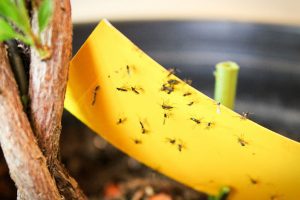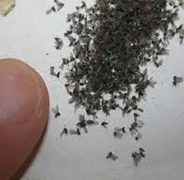Identification and Life Cycle
The Fungus Gnat, Bradysia spp., is often found in homes and offices near houseplants often running or resting on soil or leaves. They are tiny non-biting flies, that resemble mosquitoes and can be a nuisance in large numbers.
The adults are approximately 1/8 – inch long and are black or dark brown with long thin legs and an antennae. Their wings have a distinctive “Y” shaped vein. The larvae, which can be found 1 to 3 inches below the top of the soil, are worm-like in appearance with a translucent body and a black head.
They have four stages of metamorphosis; egg, larva, pupa, and adult. The adult female can lay 100-150 eggs and can hatch in as little as four days. The larva develop quickly and are fully grown in 2-3 weeks feeding on plant roots and leaves that are touching the soil’s surface. They then pupate in or on the material of which the eggs were deposited. The adults will emerge in about 7 days and will feed on fungai, algae and decaying plant matter. They have a life span of 7 to 10 days.





Comments are closed.